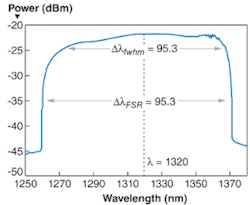Fourier-domain optical-coherence tomography (OCT) is now being widely used for biomedical imaging with a resolution of several micrometers. The improved performance is attributed mainly to new wavelength-swept laser sources with high tuning speeds and high output power. Using a Fourier-domain modelocking (FDML) technique, researchers at the University of Toronto and Ryerson University (both in Toronto, ON, Canada) have developed one of the most powerful wavelength-swept light sources to date.1 Their 52.6 mW fiber laser sweeps at a repetition rate of 62.6 kHz over a 113 nm tuning range centered at 1320 nm. The long coherence length of the source extends the OCT ranging depth to 8.1 mm with an axial resolution of 7.9 µm in air (approximately 5.8 µm in tissue, assuming a refractive index of 1.3).
The wavelength-swept source uses a broadband semiconductor optical amplifier (SOA) from Covega (Jessup, MD) as an amplifying medium in a fiber ring-laser configuration with a 3.3 km fiber delay line. A fiber-optic collimator couples light between the fiber and a polygon-based scanner that consists of an 830-lines/mm grating, a confocal telescope, a 72-facet polygon mirror from Lincoln Laser (Phoenix, AZ), and a gold-coated reflection mirror.
Beams with specific wavelength components are reflected at a specific time by the spinning polygon mirror, and are fed back to the laser cavity. The wavelength tuning range of the system is defined by the number of facets of the polygon mirror, the focal lengths of the confocal telescope system, and the period of the grating used. For a sweeping range of 112 nm and a 3.3 km fiber delay line, a 62.6 kHz sweeping rate is achieved experimentally, which agrees well with the calculated modelocked frequency of 62.7 kHz.
The coherence length of the laser source was investigated by measuring the peak Fourier sensitivities as a function of the reflection depths. An OCT ranging depth of 8.1 mm was achieved experimentally, corresponding to a 16.2 mm optical path difference in air with an 8.7 dB (1/e2) decrease in sensitivity. The Fourier components are still distinguishable even when the ranging depth exceeds 15 mm.
The researchers note that a wavelength-swept laser source with high power, high repetition rate, and long coherence length can also be used in a wide range of applications such as real-time three-dimensional biomedical imaging and optical sensing (strain and temperature) for buildings, dams, and in petroleum extraction.
REFERENCE
- G.Y. Liu et al., Optics Express 16(18) 14095 (Sept. 1, 2008).

